Linux系統通過向內核發出系統調用(system call)實現了用戶態進程和硬件設備之間的大部分接口。
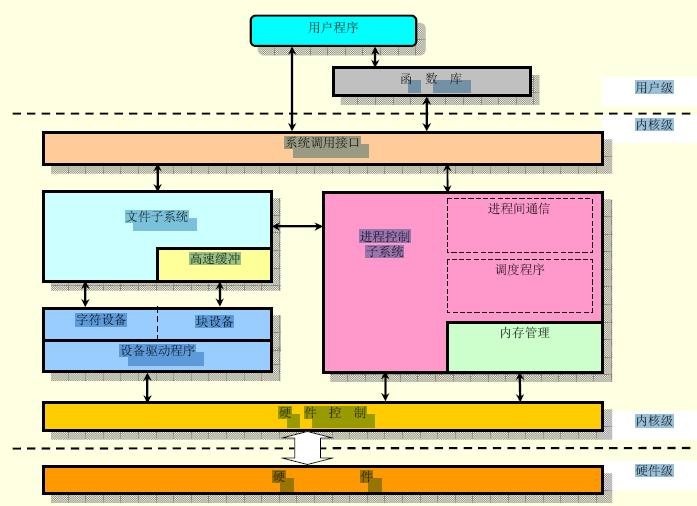
系統調用是操作系統提供的服務,用戶程序通過各種系統調用,來引用內核提供的各種服務,系統調用的執行讓用戶程序陷入內核,該陷入動作由swi軟中斷完成。
1、用戶可以通過兩種方式使用系統調用:
第一種方式是通過C庫函數,包括系統調用在C庫中的封裝函數和其他普通函數。
第二種方式是使用_syscall宏。2.6.18版本之前的內核,在include/asm-i386/unistd.h文件中定義有7個_syscall宏,分別是:
_syscall0(type,name) _syscall1(type,name,type1,arg1) _syscall2(type,name,type1,arg1,type2,arg2) _syscall3(type,name,type1,arg1,type2,arg2,type3,arg3) _syscall4(type,name,type1,arg1,type2,arg2,type3,arg3,type4,arg4) _syscall5(type,name,type1,arg1,type2,arg2,type3,arg3,type4,arg4,type5,arg5) _syscall6(type,name,type1,arg1,type2,arg2,type3,arg3,type4,arg4,type5,arg5,type6,arg6)
其中,type表示所生成系統調用的返回值類型,name表示該系統調用的名稱,typeN、argN分別表示第N個參數的類型和名稱,它們的數目和_syscall后面的數字一樣大。
這些宏的作用是創建名為name的函數,_syscall后面跟的數字指明了該函數的參數的個數。
比如sysinfo系統調用用于獲取系統總體統計信息,使用_syscall宏定義為:
_syscall1(int, sysinfo, struct sysinfo *, info);
展開后的形式為:
int sysinfo(struct sysinfo * info) { long __res; __asm__ volatile("int $0x80" : "=a" (__res) : "0" (116),"b" ((long)(info))); do { if ((unsigned long)(__res) >= (unsigned long)(-(128 + 1))) { errno = -(__res); __res = -1; } return (int) (__res); } while (0); }
可以看出,_syscall1(int, sysinfo, struct sysinfo *, info)展開成一個名為sysinfo的函數,原參數int就是函數的返回類型,原參數struct sysinfo *和info分別構成新函數的參數。
在程序文件里使用_syscall宏定義需要的系統調用,就可以在接下來的代碼中通過系統調用名稱直接調用該系統調用。下面是一個使用sysinfo系統調用的實例。
代碼清單5.1? sysinfo系統調用使用實例
#include #include #include #include /* for struct sysinfo */ _syscall1(int, sysinfo, struct sysinfo *, info); int main(void) { struct sysinfo s_info; int error; error = sysinfo(&s_info); printf("code error = %d/n", error); printf("Uptime = %lds/nLoad: 1 min %lu / 5 min %lu / 15 min %lu/n" "RAM: total %lu / free %lu / shared %lu/n" "Memory in buffers = %lu/nSwap: total %lu / free %lu/n" "Number of processes = %d/n", s_info.uptime, s_info.loads[0], s_info.loads[1], s_info.loads[2], s_info.totalram, s_info.freeram, s_info.sharedram, s_info.bufferram, s_info.totalswap, s_info.freeswap, s_info.procs); exit(EXIT_SUCCESS); }
但是自2.6.19版本開始,_syscall宏被廢除,我們需要使用syscall函數,通過指定系統調用號和一組參數來調用系統調用。
syscall函數原型為:
int syscall(int number, ...);
其中number是系統調用號,number后面應順序接上該系統調用的所有參數。下面是gettid系統調用的調用實例。
代碼清單5.2? gettid系統調用使用實例
#include #include #include #define __NR_gettid 224 int main(int argc, char *argv[]) { pid_t tid; tid = syscall(__NR_gettid); }
大部分系統調用都包括了一個SYS_符號常量來指定自己到系統調用號的映射,因此上面第10行可重寫為:
tid = syscall(SYS_gettid);
2 系統調用與應用編程接口(API)區別
應用編程接口(API)與系統調用的不同在于,前者只是一個函數定義,說明了如何獲得一個給定的服務,而后者是通過軟件中斷向內核發出的一個明確的請求。POSIX標準針對API,而不針對系統調用。Unix系統給程序員提供了很多API庫函數。libc的標準c庫所定義的一些API引用了封裝例程(wrapper routine)(其唯一目的就是發布系統調用)。通常情況下,每個系統調用對應一個封裝例程,而封裝例程定義了應用程序使用的API。反之則不然,一個API沒必要對應一個特定的系統調用。從編程者的觀點看,API和系統調用之間的差別是沒有關系的:唯一相關的事情就是函數名、參數類型及返回代碼的含義。然而,從內核設計者的觀點看,這種差別確實有關系,因為系統調用屬于內核,而用戶態的庫函數不屬于內核。
大部分封裝例程返回一個整數,其值的含義依賴于相應的系統調用。返回-1通常表示內核不能滿足進程的請求。系統調用處理程序的失敗可能是由無效參數引起的,也可能是因為缺乏可用資源,或硬件出了問題等等。在libd庫中定義的errno變量包含特定的出錯碼。每個出錯碼定義為一個常量宏。
當用戶態的進程調用一個系統調用時,CPU切換到內核態并開始執行一個內核函數。因為內核實現了很多不同的系統調用,因此進程必須傳遞一個名為系統調用號(system call number)的參數來識別所需的系統調用。所有的系統調用都返回一個整數值。這些返回值與封裝例程返回值的約定是不同的。在內核中,整數或0表示系統調用成功結束,而負數表示一個出錯條件。在后一種情況下,這個值就是存放在errno變量中必須返回給應用程序的負出錯碼。
3 系統調用執行過程
ARM Linux系統利用SWI指令來從用戶空間進入內核空間,還是先讓我們了解下這個SWI指令吧。SWI指令用于產生軟件中斷,從而實現從用戶模式變換到管理模式,CPSR保存到管理模式的SPSR,執行轉移到SWI向量。在其他模式下也可使用SWI指令,處理器同樣地切換到管理模式。指令格式如下:
SWI{cond} immed_24
其中:
immed_24??24位立即數,值為從0——16777215之間的整數。
使用SWI指令時,通常使用一下兩種方法進行參數傳遞,SWI異常處理程序可以提供相關的服務,這兩種方法均是用戶軟件協定。SWI異常中斷處理程序要通過讀取引起軟件中斷的SWI指令,以取得24為立即數。
1)、指令中24位的立即數指定了用戶請求的服務類型,參數通過通用寄存器傳遞。如:
MOV R0,#34SWI 12
2)、指令中的24位立即數被忽略,用戶請求的服務類型有寄存器R0的只決定,參數通過其他的通用寄存器傳遞。如:
MOV R0, #12MOV R1, #34SWI 0
在SWI異常處理程序中,去除SWI立即數的步驟為:首先確定一起軟中斷的SWI指令時ARM指令還是Thumb指令,這可通過對SPSR訪問得到;然后取得該SWI指令的地址,這可通過訪問LR寄存器得到;接著讀出指令,分解出立即數(低24位)。
由用戶空間進入系統調用
通常情況下,我們寫的代碼都是通過封裝的C lib來調用系統調用的。以0.9.30版uClibc中的open為例,來追蹤一下這個封裝的函數是如何一步一步的調用系統調用的。在include/fcntl.h中有定義:
# define open open64
open實際上只是open64的一個別名而已。
在libc/sysdeps/linux/common/open64.c中可以看到:
extern __typeof(open64) __libc_open64;extern __typeof(open) __libc_open;
可見open64也只不過是__libc_open64的別名,而__libc_open64函數在同一個文件中定義:
libc_hidden_proto(__libc_open64)int __libc_open64 (const char *file, int oflag, ...){ mode_t mode = 0; if (oflag & O_CREAT) { va_list arg; va_start (arg, oflag); mode = va_arg (arg, mode_t); va_end (arg); } return __libc_open(file, oflag | O_LARGEFILE, mode);}libc_hidden_def(__libc_open64)
最終__libc_open64又調用了__libc_open函數,這個函數在文件libc/sysdeps/linux/common/open.c中定義:
libc_hidden_proto(__libc_open)int __libc_open(const char *file, int oflag, ...){ mode_t mode = 0; if (oflag & O_CREAT) { va_list arg; va_start (arg, oflag); mode = va_arg (arg, mode_t); va_end (arg); } return __syscall_open(file, oflag, mode);}libc_hidden_def(__libc_open)
_syscall_open在同一個文件中定義:
static __inline__ _syscall3(int, __syscall_open, const char *, file, int, flags, __kernel_mode_t, mode)
在文件libc/sysdeps/linux/arm/bits/syscalls.h文件中可以看到:
#undef _syscall3#define _syscall3(type,name,type1,arg1,type2,arg2,type3,arg3) \type name(type1 arg1,type2 arg2,type3 arg3) \{ \ return (type) (INLINE_SYSCALL(name, 3, arg1, arg2, arg3)); \}
這個宏實際上完成定義一個函數的工作,這個宏的第一個參數是函數的返回值類型,第二個參數是函數名,之后的參數就如同它的參數名所表明的那樣,分別是函數的參數類型及參數名。__syscall_open實際上為:
int __syscall_open (const char * file,int flags, __kernel_mode_t mode){ return (int) (INLINE_SYSCALL(__syscall_open, 3, file, flags, mode));}
INLINE_SYSCALL為同一個文件中定義的宏:
#undef INLINE_SYSCALL#define INLINE_SYSCALL(name, nr, args...) \ ({ unsigned int _inline_sys_result = INTERNAL_SYSCALL (name, , nr, args); \ if (__builtin_expect (INTERNAL_SYSCALL_ERROR_P (_inline_sys_result, ), 0)) \ { \ __set_errno (INTERNAL_SYSCALL_ERRNO (_inline_sys_result, )); \ _inline_sys_result = (unsigned int) -1; \ } \ (int) _inline_sys_result; }) #undef INTERNAL_SYSCALL#if !defined(__thumb__)#if defined(__ARM_EABI__)#define INTERNAL_SYSCALL(name, err, nr, args...) \ ({unsigned int __sys_result; \ { \ register int _a1 __asm__ ("r0"), _nr __asm__ ("r7"); \ LOAD_ARGS_##nr (args) \ _nr = SYS_ify(name); \ __asm__ __volatile__ ("swi 0x0 @ syscall " #name \ : "=r" (_a1) \ : "r" (_nr) ASM_ARGS_##nr \ : "memory"); \ __sys_result = _a1; \ } \ (int) __sys_result; })#else /* defined(__ARM_EABI__) */ #define INTERNAL_SYSCALL(name, err, nr, args...) \ ({ unsigned int __sys_result; \ { \ register int _a1 __asm__ ("a1"); \ LOAD_ARGS_##nr (args) \ __asm__ __volatile__ ("swi %1 @ syscall " #name \ : "=r" (_a1) \ : "i" (SYS_ify(name)) ASM_ARGS_##nr \ : "memory"); \ __sys_result = _a1; \ } \ (int) __sys_result; })#endif#else /* !defined(__thumb__) *//* We can't use push/pop inside the asm because that breaks unwinding (ie. thread cancellation). */#define INTERNAL_SYSCALL(name, err, nr, args...) \ ({ unsigned int __sys_result; \ { \ int _sys_buf[2]; \ register int _a1 __asm__ ("a1"); \ register int *_v3 __asm__ ("v3") = _sys_buf; \ *_v3 = (int) (SYS_ify(name)); \ LOAD_ARGS_##nr (args) \ __asm__ __volatile__ ("str r7, [v3, #4]\n" \ "\tldr r7, [v3]\n" \ "\tswi 0 @ syscall " #name "\n" \ "\tldr r7, [v3, #4]" \ : "=r" (_a1) \ : "r" (_v3) ASM_ARGS_##nr \ : "memory"); \ __sys_result = _a1; \ } \ (int) __sys_result; })#endif /*!defined(__thumb__)*/
這里也將同文件中的LOAD_ARGS宏的定義貼出來:
#define LOAD_ARGS_0()#define ASM_ARGS_0#define LOAD_ARGS_1(a1) \ _a1 = (int) (a1); \ LOAD_ARGS_0 ()#define ASM_ARGS_1 ASM_ARGS_0, "r" (_a1)#define LOAD_ARGS_2(a1, a2) \ register int _a2 __asm__ ("a2") = (int) (a2); \ LOAD_ARGS_1 (a1)#define ASM_ARGS_2 ASM_ARGS_1, "r" (_a2)#define LOAD_ARGS_3(a1, a2, a3) \ register int _a3 __asm__ ("a3") = (int) (a3); \ LOAD_ARGS_2 (a1, a2)
這項宏用來在相應的寄存器中加載相應的參數。SYS_ify宏獲得系統調用號
#define SYS_ify(syscall_name) (__NR_##syscall_name)
也就是__NR___syscall_open,在libc/sysdeps/linux/common/open.c中可以看到這個宏的定義:
#define __NR___syscall_open __NR_open
__NR_open在內核代碼的頭文件中有定義。在r7寄存器中存放系統調用號,而參數傳遞似乎和普通的函數調用的參數傳遞也沒有什么區別。
在這個地方,得注意那個EABI,?EABI是什么東西呢?ABI,Application Binary Interface,應用二進制接口。在較新的EABI規范中,是將系統調用號壓入寄存器r7中,而在老的OABI中則是執行的swi中斷號的方式,也就是說原來的調用方式(Old ABI)是通過跟隨在swi指令中的調用號來進行的。同時這兩種調用方式的系統調用號也是存在這區別的,在內核的文件arch/arm/inclue/asm/unistd.h中可以看到:
#define __NR_OABI_SYSCALL_BASE?0x900000#if defined(__thumb__) || defined(__ARM_EABI__)#define __NR_SYSCALL_BASE 0#else#define __NR_SYSCALL_BASE __NR_OABI_SYSCALL_BASE#endif/* * This file contains the system call numbers. */#define __NR_restart_syscall (__NR_SYSCALL_BASE+ 0)#define __NR_exit (__NR_SYSCALL_BASE+ 1)#define __NR_fork (__NR_SYSCALL_BASE+ 2)#define __NR_read (__NR_SYSCALL_BASE+ 3)#define __NR_write (__NR_SYSCALL_BASE+ 4)#define __NR_open (__NR_SYSCALL_BASE+ 5)……
接下來來看操作系統對系統調用的處理。我們回到ARM Linux的異常向量表,因為當執行swi時,會從異常向量表中取例程的地址從而跳轉到相應的處理程序中。在文件arch/arm/kernel/entry-armv.S中:
/* * We group all the following data together to optimise * for CPUs with separate I & D caches. */ .align 5.LCvswi: .word vector_swi .globl __stubs_end__stubs_end: .equ stubs_offset, __vectors_start + 0x200 - __stubs_start .globl __vectors_start__vectors_start: ARM( swi SYS_ERROR0 ) THUMB( svc #0 ) THUMB( nop ) W(b) vector_und + stubs_offset W(ldr) pc, .LCvswi + stubs_offset W(b) vector_pabt + stubs_offset W(b) vector_dabt + stubs_offset W(b) vector_addrexcptn + stubs_offset W(b) vector_irq + stubs_offset W(b) vector_fiq + stubs_offset .globl __vectors_end__vectors_end:
而.LCvswi在同一個文件中定義為:
.LCvswi: .word vector_swi
也就是最終會執行例程vector_swi來完成對系統調用的處理,接下來我們來看下在arch/arm/kernel/entry-common.S中定義的vector_swi例程:
/*============================================================================= * SWI handler *----------------------------------------------------------------------------- */ /* If we're optimising for StrongARM the resulting code won't run on an ARM7 and we can save a couple of instructions. --pb */#ifdef CONFIG_CPU_ARM710#define A710(code...) code.Larm710bug: ldmia sp, {r0 - lr}^ @ Get calling r0 - lr mov r0, r0 add sp, sp, #S_FRAME_SIZE subs pc, lr, #4#else#define A710(code...)#endif .align 5ENTRY(vector_swi) sub sp, sp, #S_FRAME_SIZE stmia sp, {r0 - r12} @ Calling r0 - r12 ARM( add r8, sp, #S_PC ) ARM( stmdb r8, {sp, lr}^ ) @ Calling sp, lr THUMB( mov r8, sp ) THUMB( store_user_sp_lr r8, r10, S_SP ) @ calling sp, lr mrs r8, spsr @ called from non-FIQ mode, so ok. str lr, [sp, #S_PC] @ Save calling PC str r8, [sp, #S_PSR] @ Save CPSR str r0, [sp, #S_OLD_R0] @ Save OLD_R0 zero_fp /* * Get the system call number. */#if defined(CONFIG_OABI_COMPAT) /* * If we have CONFIG_OABI_COMPAT then we need to look at the swi * value to determine if it is an EABI or an old ABI call. */#ifdef CONFIG_ARM_THUMB tst r8, #PSR_T_BIT movne r10, #0 @ no thumb OABI emulation ldreq r10, [lr, #-4] @ get SWI instruction#else ldr r10, [lr, #-4] @ get SWI instruction A710( and ip, r10, #0x0f000000 @ check for SWI ) A710( teq ip, #0x0f000000 ) A710( bne .Larm710bug )#endif#ifdef CONFIG_CPU_ENDIAN_BE8 rev r10, r10 @ little endian instruction#endif#elif defined(CONFIG_AEABI) /* * Pure EABI user space always put syscall number into scno (r7). */ A710( ldr ip, [lr, #-4] @ get SWI instruction ) A710( and ip, ip, #0x0f000000 @ check for SWI ) A710( teq ip, #0x0f000000 ) A710( bne .Larm710bug )#elif defined(CONFIG_ARM_THUMB) /* Legacy ABI only, possibly thumb mode. */ tst r8, #PSR_T_BIT @ this is SPSR from save_user_regs addne scno, r7, #__NR_SYSCALL_BASE @ put OS number in ldreq scno, [lr, #-4]#else /* Legacy ABI only. */ ldr scno, [lr, #-4] @ get SWI instruction A710( and ip, scno, #0x0f000000 @ check for SWI ) A710( teq ip, #0x0f000000 ) A710( bne .Larm710bug )#endif#ifdef CONFIG_ALIGNMENT_TRAP ldr ip, __cr_alignment ldr ip, [ip] mcr p15, 0, ip, c1, c0 @ update control register#endif enable_irq
//tsk 是寄存器r9的別名,在arch/arm/kernel/entry-header.S中定義:// tsk .req?? r9???? @current thread_info
// 獲得線程對象的基地址。
get_thread_info tsk
// tbl是r8寄存器的別名,在arch/arm/kernel/entry-header.S中定義:
// tbl? .req?? r8???? @syscall table pointer,
// 用來存放系統調用表的指針,系統調用表在后面調用
adr tbl, sys_call_table @ load syscall table pointer#if defined(CONFIG_OABI_COMPAT) /* * If the swi argument is zero, this is an EABI call and we do nothing. * * If this is an old ABI call, get the syscall number into scno and * get the old ABI syscall table address. */ bics r10, r10, #0xff000000 eorne scno, r10, #__NR_OABI_SYSCALL_BASE ldrne tbl, =sys_oabi_call_table#elif !defined(CONFIG_AEABI) ?// scno是寄存器r7的別名 bic scno, scno, #0xff000000 @ mask off SWI op-code eor scno, scno, #__NR_SYSCALL_BASE @ check OS number#endif ldr r10, [tsk, #TI_FLAGS] @ check for syscall tracing stmdb sp!, {r4, r5} @ push fifth and sixth args#ifdef CONFIG_SECCOMP tst r10, #_TIF_SECCOMP beq 1f mov r0, scno bl __secure_computing add r0, sp, #S_R0 + S_OFF @ pointer to regs ldmia r0, {r0 - r3} @ have to reload r0 - r31:#endif tst r10, #_TIF_SYSCALL_TRACE @ are we tracing syscalls? bne __sys_trace cmp scno, #NR_syscalls @ check upper syscall limit adr lr, BSYM(ret_fast_syscall) @ return address ldrcc pc, [tbl, scno, lsl #2] @ call sys_* routine add r1, sp, #S_OFF
// why也是r8寄存器的別名
2: mov why, #0?@ no longer a real syscall
cmp scno, #(__ARM_NR_BASE - __NR_SYSCALL_BASE) eor r0, scno, #__NR_SYSCALL_BASE @ put OS number back bcs arm_syscall b sys_ni_syscall @ not private funcENDPROC(vector_swi) /* * This is the really slow path. We're going to be doing * context switches, and waiting for our parent to respond. */__sys_trace: mov r2, scno add r1, sp, #S_OFF mov r0, #0 @ trace entry [IP = 0] bl syscall_trace adr lr, BSYM(__sys_trace_return) @ return address mov scno, r0 @ syscall number (possibly new) add r1, sp, #S_R0 + S_OFF @ pointer to regs cmp scno, #NR_syscalls @ check upper syscall limit ldmccia r1, {r0 - r3} @ have to reload r0 - r3 ldrcc pc, [tbl, scno, lsl #2] @ call sys_* routine b 2b__sys_trace_return: str r0, [sp, #S_R0 + S_OFF]! @ save returned r0 mov r2, scno mov r1, sp mov r0, #1 @ trace exit [IP = 1] bl syscall_trace b ret_slow_syscall .align 5#ifdef CONFIG_ALIGNMENT_TRAP .type __cr_alignment, #object__cr_alignment: .word cr_alignment#endif .ltorg/* * This is the syscall table declaration for native ABI syscalls. * With EABI a couple syscalls are obsolete and defined as sys_ni_syscall. */#define ABI(native, compat) native#ifdef CONFIG_AEABI#define OBSOLETE(syscall) sys_ni_syscall#else#define OBSOLETE(syscall) syscall#endif .type sys_call_table, #objectENTRY(sys_call_table)#include "calls.S"#undef ABI#undef OBSOLETE
上面的zero_fp是一個宏,在arch/arm/kernel/entry-header.S中定義:
.macro zero_fp#ifdef CONFIG_FRAME_POINTER mov fp, #0#endif .endm//而fp位寄存器r11。
像每一個異常處理程序一樣,要做的第一件事當然就是保護現場了。緊接著是獲得系統調用的系統調用號。
然后以系統調用號作為索引來查找系統調用表,如果系統調用號正常的話,就會調用相應的處理例程來處理,就是上面的那個ldrcc??pc, [tbl, scno, lsl #2]語句,然后通過例程ret_fast_syscall來返回。
在這個地方我們接著來討論ABI的問題。現在,我們首先來看兩個宏,一個是CONFIG_OABI_COMPAT?意思是說與old ABI兼容,另一個是CONFIG_AEABI?意思是說指定現在的方式為EABI。這兩個宏可以同時配置,也可以都不配,也可以配置任何一種。我們來看一下內核是怎么處理這一問題的。我們知道,sys_call_table?在內核中是個跳轉表,這個表中存儲的是一系列的函數指針,這些指針就是系統調用函數的指針,如(sys_open)。系統調用是根據一個系統調用號(通常就是表的索引)找到實際該調用內核哪個函數,然后通過運行該函數完成的。?
????首先,對于old ABI,內核給出的處理是為它建立一個單獨的system call table,叫sys_oabi_call_table,這樣,兼容方式下就會有兩個system call table,?以old ABI方式的系統調用會執行old_syscall_table表中的系統調用函數,EABI方式的系統調用會用sys_call_table中的函數指針。?
配置無外乎以下4中:?
第一、兩個宏都配置行為就是上面說的那樣。?
第二、只配置CONFIG_OABI_COMPAT,那么以old ABI方式調用的會用sys_oabi_call_table,以EABI方式調用的用sys_call_table,和1實質上是相同的。只是情況1更加明確。?
第三、只配置CONFIG_AEABI系統中不存在sys_oabi_call_table,對old ABI方式調用不兼容。只能 以EABI方式調用,用sys_call_table。
第四、兩個都沒有配置,系統默認會只允許old ABI方式,但是不存在old_syscall_table,最終會通過sys_call_table?完成函數調用
系統會根據ABI的不同而將相應的系統調用表的基地址加載進tbl寄存器,也就是r8寄存器。接下來來看系統調用表,如前面所說的那樣,有兩個,同樣都在文件arch/arm/kernel/entry-common.S中:
/* * This is the syscall table declaration for native ABI syscalls. * With EABI a couple syscalls are obsolete and defined as sys_ni_syscall. */#define ABI(native, compat) native#ifdef CONFIG_AEABI#define OBSOLETE(syscall) sys_ni_syscall#else#define OBSOLETE(syscall) syscall#endif .type sys_call_table, #objectENTRY(sys_call_table)#include "calls.S"#undef ABI#undef OBSOLETE
另外一個為:
/* * This is the syscall table declaration for native ABI syscalls. * With EABI a couple syscalls are obsolete and defined as sys_ni_syscall. */#define ABI(native, compat) native#ifdef CONFIG_AEABI#define OBSOLETE(syscall) sys_ni_syscall#else#define OBSOLETE(syscall) syscall#endif .type sys_call_table, #objectENTRY(sys_call_table)#include "calls.S"#undef ABI#undef OBSOLETE
這樣看來貌似兩個系統調用表是完全一樣的。這里預處理指令include的獨特用法也挺有意思,在系統調用表的內容就是整個arch/arm/kernel/calls.S文件的內容這個文件的內容如下(由于太長,這里就不全部列出了):
/* * linux/arch/arm/kernel/calls.S * * Copyright (C) 1995-2005 Russell King * * This program is free software; you can redistribute it and/or modify * it under the terms of the GNU General Public License version 2 as * published by the Free Software Foundation. * * This file is included thrice in entry-common.S *//* 0 */ CALL(sys_restart_syscall) CALL(sys_exit) CALL(sys_fork_wrapper) CALL(sys_read) CALL(sys_write)/* 5 */ CALL(sys_open) CALL(sys_close) CALL(sys_ni_syscall) /* was sys_waitpid */ CALL(sys_creat) CALL(sys_link) ...
這個是同樣在文件arch/arm/kernel/entry-common.S中的宏CALL()的定義:
.equ NR_syscalls,0#define CALL(x) .equ NR_syscalls,NR_syscalls+1#include "calls.S"#undef CALL#define CALL(x) .long x
最后再羅嗦一點,如果用sys_open來搜的話,是搜不到系統調用open的定義的,系統調用函數都是用宏來定義的,比如對于open,在文件fs/open.c文件中這樣定義:
SYSCALL_DEFINE3(open, const char __user *, filename, int, flags, int, mode){ long ret; if (force_o_largefile()) flags |= O_LARGEFILE; ret = do_sys_open(AT_FDCWD, filename, flags, mode); /* avoid REGPARM breakage on x86: */ asmlinkage_protect(3, ret, filename, flags, mode); return ret;}
繼續回到vector_swi,而如果系統調用號不正確,則會調用arm_syscall函數來進行處理,這個函數在文件arch/arm/kernel/traps.c中定義:
/* * Handle all unrecognised system calls. * 0x9f0000 - 0x9fffff are some more esoteric system calls */#define NR(x) ((__ARM_NR_##x) - __ARM_NR_BASE)asmlinkage int arm_syscall(int no, struct pt_regs *regs){ struct thread_info *thread = current_thread_info(); siginfo_t info; if ((no >> 16) != (__ARM_NR_BASE>> 16)) return bad_syscall(no, regs); switch (no & 0xffff) { case 0: /* branch through 0 */ info.si_signo = SIGSEGV; info.si_errno = 0; info.si_code = SEGV_MAPERR; info.si_addr = NULL; arm_notify_die("branch through zero", regs, &info, 0, 0); return 0; case NR(breakpoint): /* SWI BREAK_POINT */ regs->ARM_pc -= thumb_mode(regs) ? 2 : 4; ptrace_break(current, regs); return regs->ARM_r0; /* * Flush a region from virtual address 'r0' to virtual address 'r1' * _exclusive_. There is no alignment requirement on either address; * user space does not need to know the hardware cache layout. * * r2 contains flags. It should ALWAYS be passed as ZERO until it * is defined to be something else. For now we ignore it, but may * the fires of hell burn in your belly if you break this rule. ;) * * (at a later date, we may want to allow this call to not flush * various aspects of the cache. Passing '0' will guarantee that * everything necessary gets flushed to maintain consistency in * the specified region). */ case NR(cacheflush): do_cache_op(regs->ARM_r0, regs->ARM_r1, regs->ARM_r2); return 0; case NR(usr26): if (!(elf_hwcap & HWCAP_26BIT)) break; regs->ARM_cpsr &= ~MODE32_BIT; return regs->ARM_r0; case NR(usr32): if (!(elf_hwcap & HWCAP_26BIT)) break; regs->ARM_cpsr |= MODE32_BIT; return regs->ARM_r0; case NR(set_tls): thread->tp_value = regs->ARM_r0; if (tls_emu) return 0; if (has_tls_reg) { asm ("mcr p15, 0, %0, c13, c0, 3" : : "r" (regs->ARM_r0)); } else { /* * User space must never try to access this directly. * Expect your app to break eventually if you do so. * The user helper at 0xffff0fe0 must be used instead. * (see entry-armv.S for details) */ *((unsigned int *)0xffff0ff0) = regs->ARM_r0; } return 0;#ifdef CONFIG_NEEDS_SYSCALL_FOR_CMPXCHG /* * Atomically store r1 in *r2 if *r2 is equal to r0 for user space. * Return zero in r0 if *MEM was changed or non-zero if no exchange * happened. Also set the user C flag accordingly. * If access permissions have to be fixed up then non-zero is * returned and the operation has to be re-attempted. * * *NOTE*: This is a ghost syscall private to the kernel. Only the * __kuser_cmpxchg code in entry-armv.S should be aware of its * existence. Don't ever use this from user code. */ case NR(cmpxchg): for (;;) { extern void do_DataAbort(unsigned long addr, unsigned int fsr, struct pt_regs *regs); unsigned long val; unsigned long addr = regs->ARM_r2; struct mm_struct *mm = current->mm; pgd_t *pgd; pmd_t *pmd; pte_t *pte; spinlock_t *ptl; regs->ARM_cpsr &= ~PSR_C_BIT; down_read(&mm->mmap_sem); pgd = pgd_offset(mm, addr); if (!pgd_present(*pgd)) goto bad_access; pmd = pmd_offset(pgd, addr); if (!pmd_present(*pmd)) goto bad_access; pte = pte_offset_map_lock(mm, pmd, addr, &ptl); if (!pte_present(*pte) || !pte_dirty(*pte)) { pte_unmap_unlock(pte, ptl); goto bad_access; } val = *(unsigned long *)addr; val -= regs->ARM_r0; if (val == 0) { *(unsigned long *)addr = regs->ARM_r1; regs->ARM_cpsr |= PSR_C_BIT; } pte_unmap_unlock(pte, ptl); up_read(&mm->mmap_sem); return val; bad_access: up_read(&mm->mmap_sem); /* simulate a write access fault */ do_DataAbort(addr, 15 + (1 << 11), regs); }#endif default: /* Calls 9f00xx..9f07ff are defined to return -ENOSYS if not implemented, rather than raising SIGILL. This way the calling program can gracefully determine whether a feature is supported. */ if ((no & 0xffff) <= 0x7ff) return -ENOSYS; break; }#ifdef CONFIG_DEBUG_USER /* * experience shows that these seem to indicate that * something catastrophic has happened */ if (user_debug & UDBG_SYSCALL) { printk("[%d] %s: arm syscall %d\n", task_pid_nr(current), current->comm, no); dump_instr("", regs); if (user_mode(regs)) { __show_regs(regs); c_backtrace(regs->ARM_fp, processor_mode(regs)); } }#endif info.si_signo = SIGILL; info.si_errno = 0; info.si_code = ILL_ILLTRP; info.si_addr = (void __user *)instruction_pointer(regs) - (thumb_mode(regs) ? 2 : 4); arm_notify_die("Oops - bad syscall(2)", regs, &info, no, 0); return 0;}
還有那個sys_ni_syscall,這個函數在kernel/sys_ni.c中定義,它的作用似乎也僅僅是要給用戶空間返回錯誤碼ENOSYS。
/* we can't #include here, but tell gcc to not warn with -Wmissing-prototypes */asmlinkage long sys_ni_syscall(void);/* * Non-implemented system calls get redirected here. */asmlinkage long sys_ni_syscall(void){ return -ENOSYS;}
系統調用號正確也好不正確也好,最終都是通過ret_fast_syscall例程來返回,同樣在arch/arm/kernel/entry-common.S文件中:
.align 5/* * This is the fast syscall return path. We do as little as * possible here, and this includes saving r0 back into the SVC * stack. */ret_fast_syscall: UNWIND(.fnstart ) UNWIND(.cantunwind ) disable_irq @ disable interrupts ldr r1, [tsk, #TI_FLAGS] tst r1, #_TIF_WORK_MASK bne fast_work_pending#if defined(CONFIG_IRQSOFF_TRACER) asm_trace_hardirqs_on#endif /* perform architecture specific actions before user return */ arch_ret_to_user r1, lr restore_user_regs fast = 1, offset = S_OFF UNWIND(.fnend )
四.聲明系統調用的相關宏
linux下的系統調用函數定義接口:
1.SYSCALL_DEFINE1~6(include/linux/syscalls.h?)
#define SYSCALL_DEFINE1(name, ...) SYSCALL_DEFINEx(1, _##name, __VA_ARGS__)#define SYSCALL_DEFINE2(name, ...) SYSCALL_DEFINEx(2, _##name, __VA_ARGS__)#define SYSCALL_DEFINE3(name, ...) SYSCALL_DEFINEx(3, _##name, __VA_ARGS__)#define SYSCALL_DEFINE4(name, ...) SYSCALL_DEFINEx(4, _##name, __VA_ARGS__)#define SYSCALL_DEFINE5(name, ...) SYSCALL_DEFINEx(5, _##name, __VA_ARGS__)#define SYSCALL_DEFINE6(name, ...) SYSCALL_DEFINEx(6, _##name, __VA_ARGS__)
2.SYSCALL_DEFINEx
#ifdef CONFIG_FTRACE_SYSCALLS#define SYSCALL_DEFINEx(x, sname, ...) \ static const char *types_##sname[] = { \ __SC_STR_TDECL##x(__VA_ARGS__) \ }; \ static const char *args_##sname[] = { \ __SC_STR_ADECL##x(__VA_ARGS__) \ }; \ SYSCALL_METADATA(sname, x); \ __SYSCALL_DEFINEx(x, sname, __VA_ARGS__)#else#define SYSCALL_DEFINEx(x, sname, ...) \ __SYSCALL_DEFINEx(x, sname, __VA_ARGS__)#endif
3.__SYSCALL_DEFINEx
#ifdef CONFIG_HAVE_SYSCALL_WRAPPERS#define SYSCALL_DEFINE(name) static inline long SYSC_##name#define __SYSCALL_DEFINEx(x, name, ...) \ asmlinkage long sys##name(__SC_DECL##x(__VA_ARGS__)); \ static inline long SYSC##name(__SC_DECL##x(__VA_ARGS__)); \ asmlinkage long SyS##name(__SC_LONG##x(__VA_ARGS__)) \ { \ __SC_TEST##x(__VA_ARGS__); \ return (long) SYSC##name(__SC_CAST##x(__VA_ARGS__)); \ } \ SYSCALL_ALIAS(sys##name, SyS##name); \ static inline long SYSC##name(__SC_DECL##x(__VA_ARGS__))#else /* CONFIG_HAVE_SYSCALL_WRAPPERS */#define SYSCALL_DEFINE(name) asmlinkage long sys_##name#define __SYSCALL_DEFINEx(x, name, ...) \ asmlinkage long sys##name(__SC_DECL##x(__VA_ARGS__))#endif /* CONFIG_HAVE_SYSCALL_WRAPPERS */
4.__SC_開頭的宏
#define __SC_DECL1(t1, a1) t1 a1#define __SC_DECL2(t2, a2, ...) t2 a2, __SC_DECL1(__VA_ARGS__)#define __SC_DECL3(t3, a3, ...) t3 a3, __SC_DECL2(__VA_ARGS__)#define __SC_DECL4(t4, a4, ...) t4 a4, __SC_DECL3(__VA_ARGS__)#define __SC_DECL5(t5, a5, ...) t5 a5, __SC_DECL4(__VA_ARGS__)#define __SC_DECL6(t6, a6, ...) t6 a6, __SC_DECL5(__VA_ARGS__)#define __SC_LONG1(t1, a1) long a1#define __SC_LONG2(t2, a2, ...) long a2, __SC_LONG1(__VA_ARGS__)#define __SC_LONG3(t3, a3, ...) long a3, __SC_LONG2(__VA_ARGS__)#define __SC_LONG4(t4, a4, ...) long a4, __SC_LONG3(__VA_ARGS__)#define __SC_LONG5(t5, a5, ...) long a5, __SC_LONG4(__VA_ARGS__)#define __SC_LONG6(t6, a6, ...) long a6, __SC_LONG5(__VA_ARGS__)#define __SC_CAST1(t1, a1) (t1) a1#define __SC_CAST2(t2, a2, ...) (t2) a2, __SC_CAST1(__VA_ARGS__)#define __SC_CAST3(t3, a3, ...) (t3) a3, __SC_CAST2(__VA_ARGS__)#define __SC_CAST4(t4, a4, ...) (t4) a4, __SC_CAST3(__VA_ARGS__)#define __SC_CAST5(t5, a5, ...) (t5) a5, __SC_CAST4(__VA_ARGS__)#define __SC_CAST6(t6, a6, ...) (t6) a6, __SC_CAST5(__VA_ARGS__)...
5.針對SYSCALL_DEFINE1(close, unsigned int, fd)來分析一下
SYSCALL_DEFINE1(close, unsigned int, fd)根據#define SYSCALL_DEFINE1(name, ...) SYSCALL_DEFINEx(1, _##name, __VA_ARGS__)
化簡SYSCALL_DEFINEx(1, _close, __VA_ARGS__)??【 ##是連接符的意思】,根據SYSCALL_DEFINEx的定義
化簡__SYSCALL_DEFINEx(1, _close, __VA_ARGS__) 根據__SYSCALL_DEFINEx的定義
#define __SYSCALL_DEFINEx(1, _close, ...) \ asmlinkage long sys_close(__SC_DECL1(__VA_ARGS__)); \ static inline long SYSC_close(__SC_DECL1(__VA_ARGS__)); \ asmlinkage long SyS_close(__SC_LONG1(__VA_ARGS__)) \ { \ __SC_TEST1(__VA_ARGS__); \ return (long) SYSC_close(__SC_CAST1(__VA_ARGS__)); \ } \ SYSCALL_ALIAS(sys_close, SyS_close); \ static inline long SYSC_close(__SC_DECL1(__VA_ARGS__))
這里__VA_ARGS__是可變參數宏,可以認為等于unsigned int, fd
根據__SC_宏化簡
#define __SYSCALL_DEFINEx(1, _close, ...) \ asmlinkage long sys_close(unsigned int fd); \ static inline long SYSC_close(unsigned int fd); \ asmlinkage long SyS_close(long fd)) \ { \ BUILD_BUG_ON(sizeof(unsigned int) > sizeof(long)) \ return (long) SYSC_close((unsigned int)fd); \ } \ SYSCALL_ALIAS(sys_close, SyS_close); \ static inline long SYSC_close(unsigned int fd)
聲明了sys_close函數
定義了SyS_close函數,函數體調用SYSC_close函數,并返回其返回值
SYSCALL_ALIAS宏
#define SYSCALL_ALIAS(alias, name) \ asm ("\t.globl " #alias "\n\t.set " #alias ", " #name)
插入匯編代碼 讓執行sys_close等同于執行SYS_close
#define SYSCALL_ALIAS(alias, name) \ asm ("\t.globl " #alias "\n\t.set " #alias ", " #name)
【#是預處理的意思】
BUILD_BUG_ON宏是個錯誤判斷檢測的功能
最后一句是SYSC_close的函數定義
所以在SYSCALL_DEFINE1宏定義后面緊跟的是{}包圍起來的函數體
6.根據5的解析可推斷出
SYSCALL_DEFINE1的'1'代表的是sys_close的參數個數為1
同理SYSCALL_DEFINE?的'/'代表的是sys_name的參數為'?'個
7.系統調用函數的定義用SYSCALL_DEFINE宏修飾
系統調用函數的外部聲明在include/linux/Syscalls.h頭文件中
5 添加新的系統調用
第一、打開arch/arm/kernel/calls.S,在最后添加系統調用的函數原型的指針,例如:
CALL(sys_set_senda)
補充說明一點關于NR_syscalls的東西,這個常量表示系統調用的總的個數,在較新版本的內核中,文件arch/arm/kernel/entry-common.S中可以找到:
.equ NR_syscalls,0#define CALL(x) .equ NR_syscalls,NR_syscalls+1#include "calls.S"#undef CALL#define CALL(x) .long x
相當的巧妙,不是嗎?在系統調用表中每添加一個系統調用,NR_syscalls就自動增加一。在這個地方先求出NR_syscalls,然后重新定義CALL(x)宏,這樣也可以不影響文件后面系統調用表的建立。
第二、打開include/asm-arm/unistd.h,添加系統調用號的宏,感覺這步可以省略,因為這個地方定義的系統調用號主要是個C庫,比如uClibc、Glibc用的。例如:
#define __NR_plan_set_senda (__NR_SYSCALL_BASE+365)
為了向后兼容,系統調用只能增加而不能減少,這里的編號添加時,也必須按順序來。否則會導致核心運行錯誤。
第三,實例化該系統調用,即編寫新添加系統調用的實現例如:
SYSCALL_DEFINE1(set_senda, int,iset){ if(iset) UART_PUT_CR(&at91_port[2],AT91C_US_SENDA); else UART_PUT_CR(&at91_port[2],AT91C_US_RSTSTA); return 0;}
第四、打開include/linux/syscalls.h添加函數聲明
asmlinkage long sys_set_senda(int iset);
第五、在應用程序中調用該系統調用,可以參考uClibc的實現。
第六、結束。
?
 電子發燒友App
電子發燒友App


















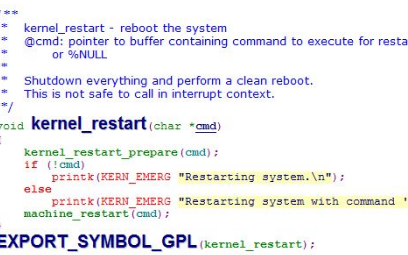
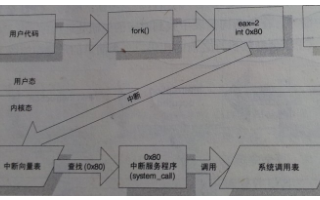
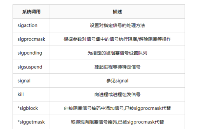

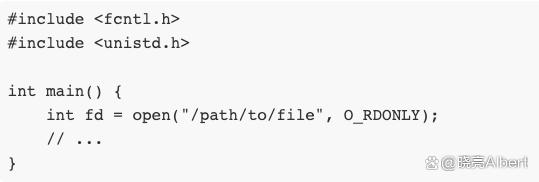
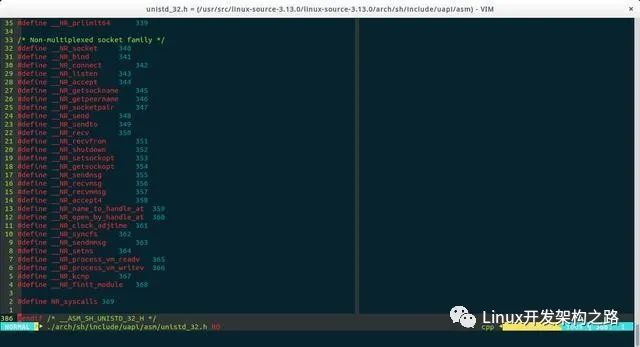
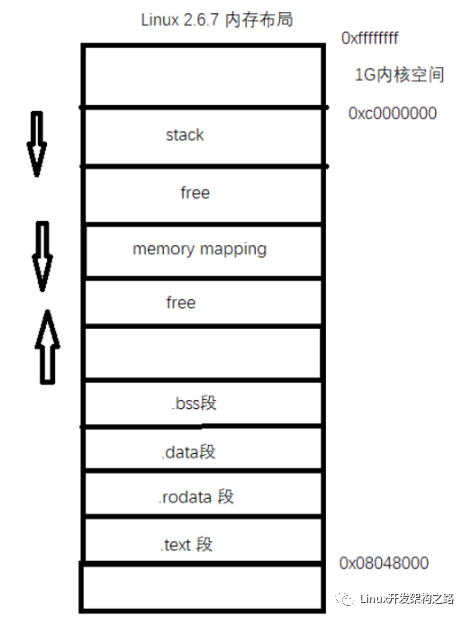










評論